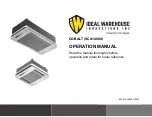
3 Third party components
Service manual
47
ATXP20~3 FTXP20~7 ARXP20~3
RXP20~71L2V1B
Split Comfora R32
ESIE18-01 – 2019.02
Repair information
Refrigerant piping handling
▪ Make sure that the applied pressure is never higher than the unit
design pressure indicated on the nameplate (PS).
▪ Work according to the F‑gas regulation and/or local regulations.
▪ Make sure the correct amount of refrigerant is charged after repair
according to the F‑gas regulation label on the unit (factory +
additional where required).
▪ Make sure to use the appropriate equipment and tools according
to the refrigerant and unit type.
▪ Charge non‑azeotropic refrigerant (e.g. R410A) always in a liquid
state.
▪ R32 can be charged in gas phase.
▪ Make sure to use a digital scale (no charging cylinder).
▪ Execute correct vacuum drying procedure after repair:
▪ –0.1 MPa / –760 mm Hg / –750 Torr / –1 bar for at least 1 hour.
▪ Connect the unit according to the available service ports.
▪ Use related field setting where necessary to open expansion
valve / solenoid valve.
To perform refrigerant pump down operation
The unit is equipped with an automatic pump down operation which
will collect all refrigerant from the field piping and indoor unit in the
outdoor unit. To protect the environment, make sure to perform the
following pump down operation when relocating the unit.
DANGER: RISK OF EXPLOSION
Pump down – Refrigerant leakage.
If you want to pump
down the system, and there is a leak in the refrigerant
circuit:
▪ Do NOT use the unit's automatic pump down function,
with which you can collect all refrigerant from the
system into the outdoor unit.
Possible consequence:
Self-combustion and explosion of the compressor
because of air going into the operating compressor.
▪ Use a separate recovery system so that the unit's
compressor does NOT have to operate.
CAUTION
Some outdoor units are equipped with a low pressure
switch to protect the compressor by switching it off.
NEVER short‑circuit the low pressure switch during pump
down operation.
1
Remove the refrigerant connection cover, see
2
Remove the cap from the stop valves.
3
Perform pump down operation, see installer reference guide for
the correct procedure.
4
After 5~10 minutes (after only 1~2 minutes in case temperature
<–10°C), close the liquid stop valve using a hexagonal wrench.
5
Check the manifold if vacuum is reached. Close the gas stop
valve and stop forced cooling operation.
Refrigerant piping repair
▪ Make sure to cover open pipe ends during repair so no dust or
moisture can enter.
▪ Make sure to re‑apply insulation removed during repair.
▪ Pipe expansion / flare making:
▪ Remove any burrs on the cut surface using the correct tool
such as reamer or scraper (note that excessive deburring can
thin the pipe walls and cause cracking of the pipe).
▪ Make sure the flare has the correct size (use a flare gauge).
▪ Make sure no particles remain in the piping.
▪ Apply just a drop of refrigerant oil on the inner surface of the
flare.
▪ Make sure the flare connection is tightened with the correct
torque (torque values refer to installation manual).
▪ Brazing:
▪ Use the correct brazing tool.
▪ Use a phosphor copper filler metal (silver composition of 0 to
2%). Do not use flux material.
▪ Flush the piping before brazing with nitrogen to avoid oxidation
of the inside of the copper tubes (nitrogen purity ≥99.99%).
3.3
External factors
3.3.1
Checking procedures
To check the outdoor temperature
1
The outdoor unit is designed to operate within a temperature
range of –25°C and 35°C. If the outdoor temperature is outside
this range, the outdoor unit may stop operating.
Is the outdoor temperature
within the operating range?
Action
Yes
Return to the troubleshooting of
the specific error and continue
with the next procedure.
No
Wait for the outdoor temperature
to return within the operating
range.
To check for objects that may block the airflow
1
Check for the presence of objects near the indoor unit that may
block the airflow.
Is an object found that may
block the airflow?
Action
Yes
Remove the object, see
"3.3.2 Repair procedures" on
page 47
No
Return to the troubleshooting of
the specific error and continue
with the next procedure.
3.3.2
Repair procedures
To remove objects that may block the airflow
1
Remove objects that may block the airflow from the near
environment of the indoor unit.
Is the problem solved?
Action
Yes
No further actions required.
No
Return to the troubleshooting of
the specific error and continue
with the next procedure.
















































